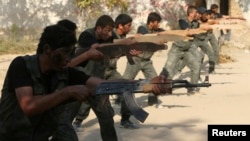Turkey agreed in mid-February to join the United States in a train-and-equip program for Syrian rebel fighters, but Ankara and Washington have not ironed out their differences over the aims of the program.
Turkish officials have stressed they see the toppling of Syrian President Bashar al-Assad to be as important as battling Islamic State militants. While U.S. officials have made clear the objective of the military training program is solely to battle Islamic State fighters.
On Monday, Turkish Defense Minister Ismet Yilmaz said in Ankara the training program for Syrian opposition forces will be held in Turkey’s central Anatolia province of Kirikkale.
“Turkey and the United States will set up a joint commission. This commission will decide on the people who will be trained,” Yilmaz said. But he also emphasized that Syrian fighters trained in the joint program are expected to fight Assad as well as Islamic State militants.
The agreement with the U.S., reached after several months of negotiations, parallels a similar one with the Gulf states of Qatar and Saudi Arabia.
The U.S. funding for the train-and-equip program is separate from money used to pay about a dozen rebel militias fighting in northern Syria and dozens in the south of the country, which are headquartered out of Jordan.
Central part of US strategy
The American mission to train and equip Syrian moderate opposition fighters was presented to the U.S. Congress as a central part of the Obama administration's strategy to degrade and ultimately defeat the Islamic State group.
In his State of the Union address earlier this year, President Barack Obama focused his Syria remarks on the train-and-equip plan to build a proxy force targeting Islamic State militants.
Pentagon spokesman Rear Admiral John Kirby, a day before the accord with Turkey was signed, emphasized to reporters in Washington that fighting the Islamic State group would be the aim of the program.
“The fight is against [ISIL] and [ISIL] only as far as the coalition is concerned,” Kirby said, referring to an acronym for the group.
But Turkish officials have not moved from their position that the train-and-equip program should also be used to bolster the broader Syrian opposition in its efforts to oust President Assad.
Last month in announcing the deal, Foreign Minister Meylut Cavusoglu said, “The aim of the program is to ensure a political transition and strengthen the opposition in their fight against threats such as extremism, terrorism and all elements that pose a threat to the opposition, including from the regime (of Assad)."
Divergent views
The divergent views about the main objective of the program could cause problems in the future between Ankara and Washington, analysts warn.
Max Abrahms, a member of the Council on Foreign Relations and a political science professor at Northwestern University, warns of a breakdown in the program.
“The U.S. sees radical Sunni Islam as the threat in the form of ISIL and al-Qaida. Turkey sees that threat as secondary to their worries about Assad and the Kurds,” Abrahms told VOA. “The political preference of Ankara and Washington are not aligned.”
There have also been differences between Washington and Ankara about the timetable for the program.
Last month, Turkish officials said training would start March 1, but Pentagon spokesmen said the program will get off the ground “in the coming months.” On Friday, Pentagon spokesman Kirby said about four to six weeks.
There is also confusion about the recruitment of fighters for the program.
Rebel commanders from several brigades have told VOA they have no interest in seconding from frontline ranks any of their fighters to train for a proxy force to fight the Islamic State group.
“Why would I do that? I need all the men I have,” said Abdul Rahman, a commander with Jaysh al-Mujahedeen or Army of Mujahedeen, an Islamist-leaning brigade that emerged from villages and towns in the countryside northeast of Aleppo.
Potential recruits
Many rebel commanders said they have not been approached to supply recruits, saying they do no know where the United States will get the 5,000 fighters the Obama administration officials said they plan to train this year.
U.S. officials said 1,500 potential recruits have been identified, but caution they still need to be vetted for the training sessions.
A State Department official told VOA it was difficult to recruit for the program from established rebel brigades.
The official said recruiters for the train-and-equip mission are now trawling among rebel fighters from eastern Syria who disbanded and fled to Turkey when Islamic State fighters overran their territory last year.
U.S. officials also said they hope to recruit a number of fighters from the secular militia Harakat al-Hazm, a trusted U.S.-backed brigade that announced Sunday it is dissolving to join a larger Islamist insurgent alliance.
The dissolution of Hazm followed weeks of attacks from the jihadist Islamic State rival, the al-Qaida affiliated Jabhat al-Nusra, which captured the last Hazm redoubt outside Aleppo, killing as many as 300 fighters, according to opposition activists.










